RESEARCHED, TESTED, PROVEN, AND FREE ADVICE FROM THE EXPERTS
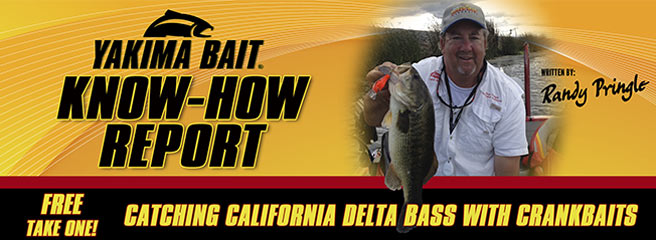
The California Delta is located 30 miles east of San Francisco Bay, where the Sacramento, San Joaquin and other rivers widen and braid into many side channels, sloughs and points of land. The Delta, as it’s often referred to, is regarded as one of the five best bass fishing destinations in America; and while Largemouth Bass are the target species for most anglers, there are many other fish types available, including Spotted and Smallmouth Bass, Perch, Sunfish, Crappie, Bluegill, Stripers, and Salmon. I’ve caught the fish listed above and more while targeting Black Bass from this angling wonderland.
Although you can catch bass from the Delta all year long, the best fishing can be had from March through November. While many of the Black Bass average 2-to-3 pounds, fish weighing in at 7-to-10 pounds are common. Although fish larger than 10 pounds are caught less frequently, they do exist; for example, on one recent year my clients and I landed 13 Black Bass that weighed in excess of 10 pounds. The largest bass I’ve landed is a 15.56 pound monster taken in 2012. Just for the record, the biggest Largemouth Bass taken from the California Delta tipped the scale at over 19 pounds.
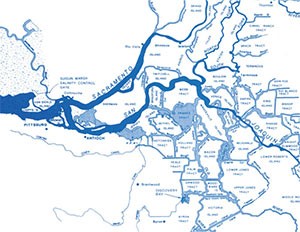 Sacramento River Delta
Sacramento River DeltaThe Delta, which encompasses a 1,100 square miles area, is surrounded by the communities of Antioch, Sacramento, Stockton, and Tracy. The boat launch site you choose may depend on where you’re traveling from; for example, many San Francisco area anglers launch their boats at Russo’s Marina on Bethel Island, anglers traveling from Sacramento put their boats in at B&W (off Hwy 12), and many Valley and Sacramento anglers depart from Buckley Cove in Stockton – also known as Ladds.
Where you decide to fish may depend on what species you desire; for example, if you’re fishing for Largemouth Bass, you should concentrate your efforts on the central portion of the Delta (near Antioch, Stockton and Tracy) where Black and Florida strain Largemouth Bass are the most numerous. If it’s Smallmouth and Spotted Bass you crave the upper Delta near where the cold water from Sacramento and San Joaquin River arms join the Delta will likely offer the best opportunity.
FLUCUATING TIDES
Keep in mind that ocean tides affect the Delta with daily fluctuations that can change the water level as much as 3-to-4 feet and play an important role in where bass can be found. A variation in water height can cause you to change the lure or methods you fish; for example, an outgoing tide will lower the water level and may expose or reduce the water depth to only a few feet above a weed bed that, just a few hours earlier, was producing fish on a shallow running crankbait. During this time of the tide you might try switching to a topwater plug (my favorite topwater is the Poe’s® Ace-In-The-Hole™) or fast crank a spinnerbait just above the weeds. As the water continues to drop, exposing the weeds, you should try switching locations or if large numbers of bass are present, try running medium to deep diving crankbaits just outside the weed line in 5-to-13 feet of water.
There are two incoming tides and two outgoing tides in a 24hr day, with the tide changing direction every six hours or so with the current going slack in between. To avoid having to battle heavy currents, fish will normally position themselves on the downstream side of land points extending into the channel when the tide is flooding only to switch to the opposite side of the point as the tide begins to change.
FISHING CRANKBAITS
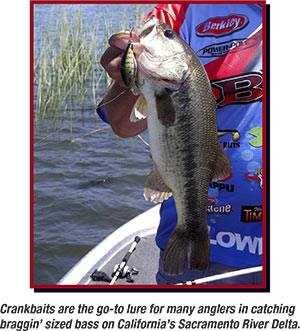 When it comes to locating big bass from the Delta, my favorite fishing method is to cast and retrieve bass plugs – often referred to as “crank- baits.” With crankbaits you can quickly cover a large amount of water to determine where fish are located. Once found, I work the fish over by experimenting with different plug colors, variations of retrieve and plugs capable of diving to different depths until I determine what works best.
When it comes to locating big bass from the Delta, my favorite fishing method is to cast and retrieve bass plugs – often referred to as “crank- baits.” With crankbaits you can quickly cover a large amount of water to determine where fish are located. Once found, I work the fish over by experimenting with different plug colors, variations of retrieve and plugs capable of diving to different depths until I determine what works best.
If there is one thing I’ve learned it’s that the least effective way to fish a crankbait is to retrieve it in a steady, rigid retrieve mode. Bass are predators looking for an easy meal, but not too easy – as they want to be teased into striking. My best technique is deflection, making your plug run into any kind of structure that will make it change its course and will give the illusion that it is injured. Bass can’t stand it.
If, while retrieving, your plug hits underwater structure, stop reeling for a few seconds and allow your plug to float away from a possible snag, then try a fast start or a false start – where you retrieve a few feet of line and then stop reeling again before resuming your retrieve. Another tactic worth doing is to lower and raise your rod tip while retrieving, which will alter the depth your plug is running. All of the above maneuvers will add greatly to your success, so much in fact that you might find yourself fishing crankbaits far more than you ever thought possible.
If you don’t have the structure to deflect off of, my advice is to retrieve your plug in an erratic, injured looking fashion with lots of stops, pauses, fast and medium starts while eventually retrieving your plug back to you for the next cast. It’s important to add every conceivable “bonus” movement to the retrieve of your crankbait until you determine which erratic action the fish like best.
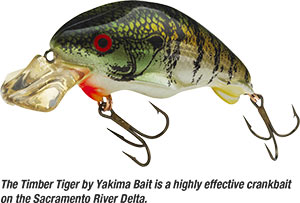 Once I’ve found where bass are holding, in addition to the above, I refine my color selection by trying different finishes until I hit on what the fish like best. Believe me, the bass will quickly tell you which plug colors they like with arm wrenching approval. And while local tackle shops are likely to stock the best producing plug colors for the Delta, the following colors should be part of your arsenal:
Once I’ve found where bass are holding, in addition to the above, I refine my color selection by trying different finishes until I hit on what the fish like best. Believe me, the bass will quickly tell you which plug colors they like with arm wrenching approval. And while local tackle shops are likely to stock the best producing plug colors for the Delta, the following colors should be part of your arsenal:
Crawdads: Each body of water has different species and colors of crawdads and the exact color may vary depending on the time of year. The crawdad colors that work best for me on the Delta are the Mean Green Craw and Crystal Super Craw available in the Timber Tiger® line of crankbaits.
Panfish: Bluegill, Crappie, Sunfish, and Perch all inhabit the Delta and bass will sometimes focus on one or more of these panfish types depending on the time of year and what other more abundant forage might be available. While my favorite panfish color is the Bull Bluegill, I’ve taken many bass on the Bluegill-Perch and the Pumpkin Seed colors.
Baitfish: These could include any other species that happens to be available from juvenile striped bass, small shad to salmon smolt. These baitfish types may only be available for a short time period, but if the bass are focusing on baitfish a close representation may be all they will strike. At times you will need to be prepared to match-the-hatch with your plug color or go home empty handed. My three favorites for the baitfish category are Tennessee Shad, Bleeding Shad and Chartreuse Shad.
Water color can have a big impact on what color combinations might work; for example, when the water is off color or dingy try Chartreuse or Fire Tiger colors. When the water is clear, a more subtle or translucent color, like Sexy Shad, would be my first choice.
CRANKBAITS
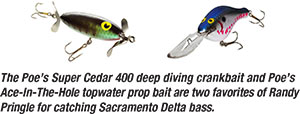 While bass plugs “crankbaits” come in all sorts of shapes and sizes it’s the key features, such as action, their fish-calling vibration and diving depth that most determine a plug’s effectiveness. The Timber Tiger® is my go-to crankbait for these reasons. While the body shapes of all Timber Tigers feature what the company calls “Timber-Guards” that guide its hooks away from obstacles resulting in fewer hang ups, it’s the plugs diving capability (seven sizes capable of diving from 2 to 16 feet) that determines my favorites for Delta bass. Given the average water depths available in the Delta, the DC-4 and DC-8 are the Timber Tiger sizes I rely on most often.
While bass plugs “crankbaits” come in all sorts of shapes and sizes it’s the key features, such as action, their fish-calling vibration and diving depth that most determine a plug’s effectiveness. The Timber Tiger® is my go-to crankbait for these reasons. While the body shapes of all Timber Tigers feature what the company calls “Timber-Guards” that guide its hooks away from obstacles resulting in fewer hang ups, it’s the plugs diving capability (seven sizes capable of diving from 2 to 16 feet) that determines my favorites for Delta bass. Given the average water depths available in the Delta, the DC-4 and DC-8 are the Timber Tiger sizes I rely on most often.
Realize too, the Delta’s diverse habitat includes miles of rocky (rip-rap) shoreline, weed beds, flooded woodlands and tules (tall reeds and grass). Given this type of varied habitat and water depths sometimes calls for the use of even shallower running plugs like the DC-2, DC-3 or deeper diving DC-13 Timber Tiger. Another deep diving plug that produces espe- cially well for me is the Poe’s® Super CedarTM 400, which has a diving range of 10-to-16 feet.
Realize the diving depth of the Timber Tiger and Poe’s Super Cedar where determined using 10-pound test line and that spooling up with a lighter/thinner test will allow these plugs to dive a foot or two deeper while spooling up with a thicker or heavier pound test line, say 15-to-20 pound, will reduce the plugs’ ability to dive. Casting distance can influ- ence a plugs diving depth too, as a long cast will allow the plug to go deeper. In addition, rod tip position can influence a plugs ability to dive; for example, holding your rod tip high will result in a shallower dive, while pointing the tip of your rod into the water while retrieving will result in a deeper dive.
FISHING LINES
When it comes to fishing for bass on the Delta, monofilament lines remain the number one choice due to their ease of use and low cost. In addition, monofilament lines are somewhat buoyant so fishing mono can make it easier to float your plug away from underwater structure when you stop reeling.
Fluorocarbon lines are popular in clear water because they are nearly invisible to wary fish. In addition, fluorocarbon lines, being more abrasion resistant than mono, are great when casting into rocky areas that can chafe other lines. Unlike monofilament, fluorocarbon sinks so if you want your plug to dive deep they may be worth considering. Keep in mind that fluorocarbon lines resist twisting even more than monofilament, mean- ing they can become very unruly when used on a spinning reel in tests over 10-pound.
Super lines, like Fireline®, Nanofil® or Spiderwire® being thinner than either monofilament or fluorocarbon will allow your crankbaits to dive deep. In addition, super lines are great when fishing around weeds because they act like a machete cutting through some of the worst type of shrubbery.
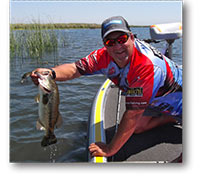
As a professional angler, tournament winner, seminar speaker and guide Randy Pringle is regarded as one of the most knowledgeable bass anglers around. His passion for the sport and willingness to share his vast knowledge make him a big draw at his many fishing seminars, lectures, television appearances, and in his writings. In addition to all of the above, his Fishing Instructor-Guide Service keeps Randy busy guiding clients to fishing success on the California Delta 200 days a year. Check him out at www.thefishinginstructor.com.

